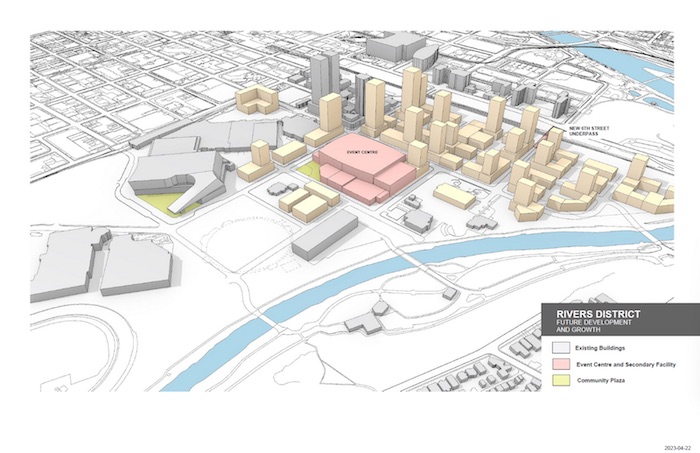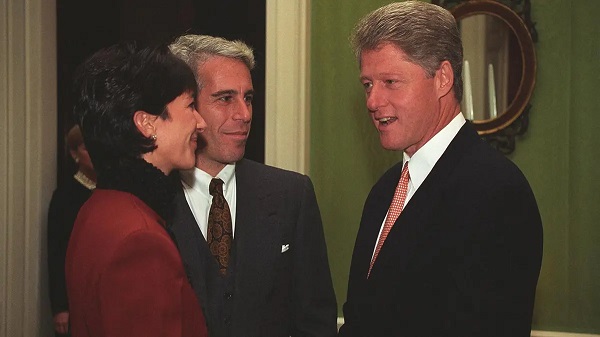Alberta
Revitalizing downtown Calgary: Province

Alberta’s government is investing up to $330 million over five years to support the Calgary Rivers District and Event Centre and revitalize downtown Calgary.
In April 2023, Alberta’s government signed a memorandum of understanding with the City of Calgary and Calgary Exhibition and Stampede Ltd. to invest in infrastructure to support the new event centre while revitalizing Calgary’s Rivers District, the Stampede grounds and downtown. The provincial funding has now been approved by cabinet and Treasury Board.
“Calgary is a city of big dreams, big projects and big expectations. Our investment in the Rivers District is one that helps build Calgary and continues the momentum of revitalization in the downtown core. It’s one more shot of energy for Calgary’s culture, entertainment and business scenes, and the city and province will reap the economic benefits for decades to come.”
The funding will support land acquisition, site utilities and transportation infrastructure for the Calgary arena and entertainment district project. The investment will also cover 50 per cent of the construction costs of a new 1,000-seat community arena that will serve youth and amateur hockey. Once complete, the Rivers is expected to create 1,500 permanent jobs and welcome an estimated 8,000 new residents and three million annual visitors to the Culture and Entertainment District.
“Alberta is proud to be a key funding partner for this project to help ensure Calgary has the infrastructure it needs to support a vibrant events district, enhance the downtown core and promote economic development, now and in the future. This contribution is an investment in the long-term economic sustainability of Calgary’s downtown.”
“This community rink will add to Calgary’s already vibrant downtown. It will provide a hub for athletes and their families to gather, share in a love for sport and make lifelong connections. And the increase in visitors to the area will help spur the local economy.”
“The Calgary Rivers District and Event Centre project will provide a tremendous boost to the local economy and create thousands of planning, design and construction-related jobs. Infrastructure will support our partner ministries in any we can to ensure the project is completed in an efficient and timely manner, and that Calgarians get the top-notch arena and entertainment district they’ve been waiting for.”
“Our province has a strong history of hosting major national and international events. I see great synergy and potential to grow Calgary’s reputation as a global destination for festivals and sporting events through our government’s continued investment.”
The province’s investment in the project includes new transportation infrastructure and improvements to existing transportation infrastructure, indoor and outdoor gathering spaces, a community rink and demolition of the existing Saddledome. Once complete, the Rivers District project will add an estimated four million square feet of mixed-use development (homes, retail, hotels) in Calgary’s Culture and Entertainment District.
Agreements among all parties, including the City of Calgary, Calgary Sports and Entertainment Corporation and Calgary Stampede, have been signed and executed, paving the way for work to begin immediately.
“The completion of this project will bring benefits for all Calgarians, and we’re one step closer to its realization. We are fortunate to have partners, including the Government of Alberta, who realize the enormous potential that this district has for Calgary as a year-round hub of sports, arts and entertainment. It will attract commercial investment to our downtown core and contribute to our city’s vibrancy and economic growth.”
“At this critical moment when we are seeing explosive population growth and increasing private sector interest in our city, the confirmation that our Culture and Entertainment District is proceeding to design and construction phases will generate strong investor confidence. This project will create better public gathering spaces, improved transportation networks, a downtown community rink and an arena to drive events that spur hosting and tourism opportunities, along with creation of jobs in the construction, retail and entertainment sectors.”
Quick facts
- The total project cost is estimated at $1.22 billion:
- The City of Calgary will contribute $537.3 million (44 per cent).
- The remaining $686 million (56 per cent) of the project costs will be covered by the Alberta government ($330 million, 27 per cent) and the Calgary Sports and Entertainment Corp. ($356 million, 29 per cent).
Alberta
Prominent conservative lawyer in Canada disbarred in ‘vindictive abuse of process’

![]()
In 2021, the Alberta Law Society expressly delegated disciplinary proceedings against Mr. Carpay to the Manitoba Law Society regarding a matter involving surveillance of government officials, including a Manitoba judge. The surveillance was performed in June 2021, for no other reason than to illuminate a legitimate public policy question: were politicians and judges complying with the stringent Covid restrictions that they themselves had imposed on the public?
Mr. Carpay acknowledged that including a judge in the surveillance was a mistake. He publicly apologized for his error in judgment in July 2021.
In August 2021, the Alberta Law Society explained in unequivocal language that it was delegating disciplinary proceedings to the Manitoba Law Society, and that the Alberta Law Society was closing its file and taking no further steps.
The Manitoba Law Society proceedings against Mr. Carpay concluded in August 2023. Mr. Carpay was ordered to pay $5,000 and to respect a lifetime ban on practicing law in Manitoba.
In October 2023, Manitoba Crown Prosecutors stayed all criminal charges against Mr. Carpay, who was innocent of any criminal wrongdoing.
In December 2023, Mr. Carpay submitted his letter of resignation to the Alberta Law Society.
However, the Alberta Law Society then refused to accept Mr. Carpay’s resignation, and commenced new disciplinary proceedings against him, regarding the same conduct for which Mr. Carpay had already been disciplined and punished by the Manitoba Law Society.
A hearing before the Alberta Law Society finally took place on May 28, 2025 – nearly four years after the incident had occurred.
The Alberta Law Society’s decision to refuse Mr. Carpay’s resignation, and to commence brand new disciplinary proceedings over the same issues after delegating the matter to the Manitoba Law Society, is a vindictive and petty abuse of process.
Mr. Carpay has not practiced law for years. He last appeared in court on behalf of a client in 2015. The Justice Centre for Constitutional Freedoms has no staff lawyers, and all legal work is done by outside counsel.
All legal costs related to this matter have been and continue to be covered entirely by Mr. Carpay.
Tuesday’s decision does not impact the vital work of John Carpay or the Justice Centre for Constitutional Freedoms. We continue to defend the constitutional rights and freedoms of all Canadians.
Alberta
Teacher strikes should never happen in Alberta

From the Fraser Institute
In Manitoba, teachers voluntarily gave up the right to strike in the 1950s in exchange for binding arbitration. There’s no evidence this decision harmed Manitoba’s education system. In fact, salaries for Manitoba teachers are currently among the highest in the country.
Alberta students are back in school. But for how long?
That’s an open question, because Alberta teachers are currently in a legal strike position. In June, almost 95 per cent of public school teachers voted to authorize strike action. With talks breaking off recently between the Teachers’ Employer Bargaining Association (which represents school boards in the province) and the Alberta Teachers’ Association (which represents teachers in all Alberta public, separate and francophone schools), prospects for a negotiated settlement don’t look good.
The dispute between the two sides is mainly about money. According to the union, the Alberta government is woefully underfunding public education, teacher salaries are too low, classes are too big, and schools lack basic education supplies. The government, of course, disputes these claims and argues that school boards receive more than enough money to educate all students.
Which side is right?
It depends on how you interpret the numbers. While per-student spending in Alberta is lower than the Canadian average, student academic achievement in math, science and reading is well above the Canadian average. There’s no reason to assume that spending more money will automatically lead to better academic results.
Even so, neither side is likely to budge. That’s unfortunate because the people most impacted by a potential strike (students and parents) are without a voice in this dispute. Regardless of which side has the better case, students and their parents will suffer the most during a strike.
This is why Alberta public school teachers shouldn’t have the right to strike. Instead, unresolved labour disputes should automatically go to binding arbitration, where a neutral third party listens to both sides make their respective cases, and then draws up a new collective agreement. Throughout this process students would remain in class and their learning would continue.
Binding arbitration is already a widely accepted way to settle labour disputes. For example, essential workers such as police officers and firefighters regularly use binding arbitration to settle their labour disputes. Given the essential nature of educating students, it’s reasonable to add teachers to this list.
Significantly, there’s precedent for moving in this direction. In Manitoba, teachers voluntarily gave up the right to strike in the 1950s in exchange for binding arbitration. There’s no evidence this decision harmed Manitoba’s education system. In fact, salaries for Manitoba teachers are currently among the highest in the country. Instead of walking a picket line trying to pressure the provincial government to give in to their demands, Manitoba teachers—and students—remain in the classroom until binding arbitration produces a settlement.
In addition, binding arbitration can be used to address more than salary disputes. For example, after a bitter year-long series of intermittent teacher strikes and work-to-rule action, the Saskatchewan government and the Saskatchewan Teachers’ Federation (STF) agreed earlier this year to use binding arbitration to resolve the thorny issue of “classroom complexity”—essentially, how to support students with complex needs. The STF was happy when the Arbitration Board’s final decision placed specific requirements on the province to address the classroom complexity issue.
Imagine how much better it would have been if Saskatchewan students and parents hadn’t suffered a year of labour uncertainty prior to this decision. And of course, teachers lost pay because of the intermittent strikes. Had their labour dispute gone to binding arbitration right away, Saskatchewan teachers would have received reasonable salary increases and a framework for addressing classroom complexity, all without threatening to strike.
Back in Alberta, parents are scrambling to make contingency plans for how they will look after their children if public schools close because of a teacher strike. Alberta has an opportunity to learn from what has happened elsewhere. Students and parents deserve the certainty of knowing that schools will remain open. Teacher strikes should never happen in Alberta. The Smith government should classify teachers as an essential service, and unresolved labour issues should be sent to binding arbitration.
Michael Zwaagstra is a senior fellow with the Fraser Institute.









